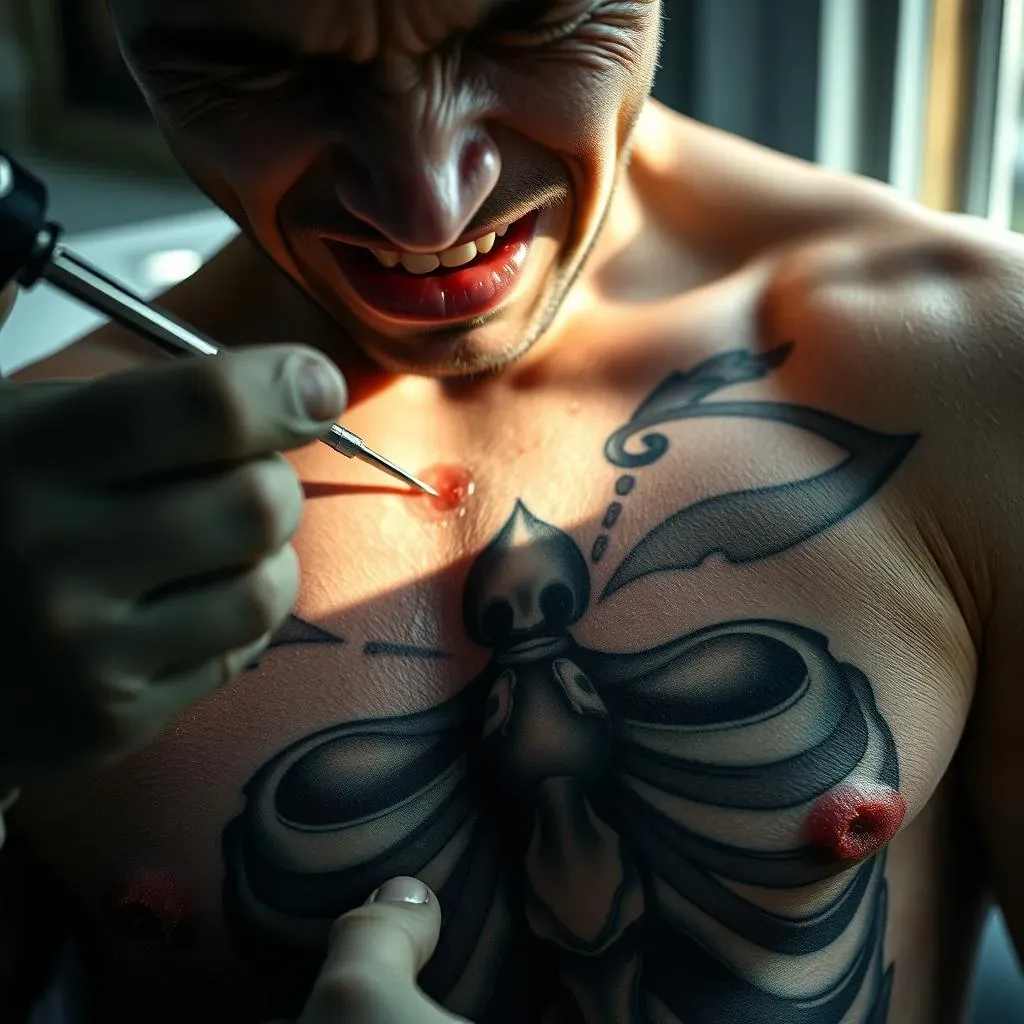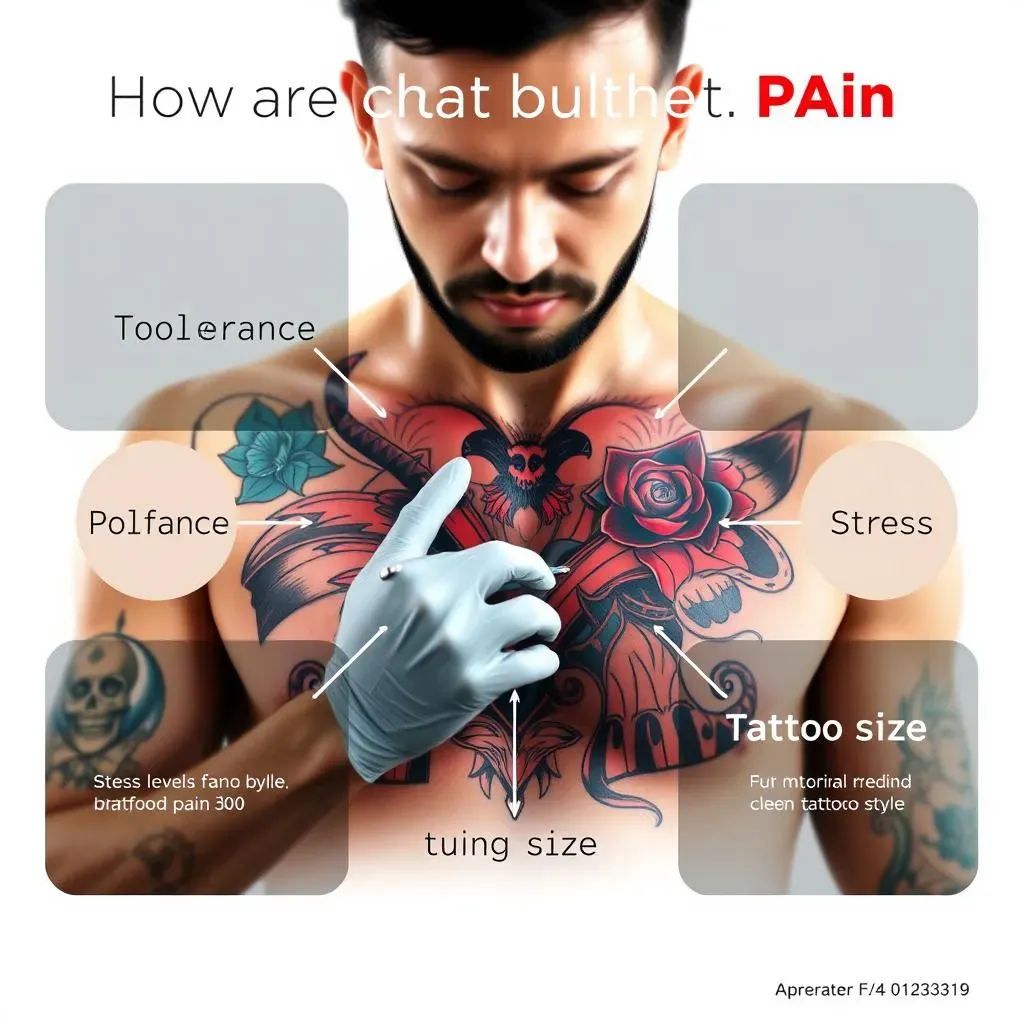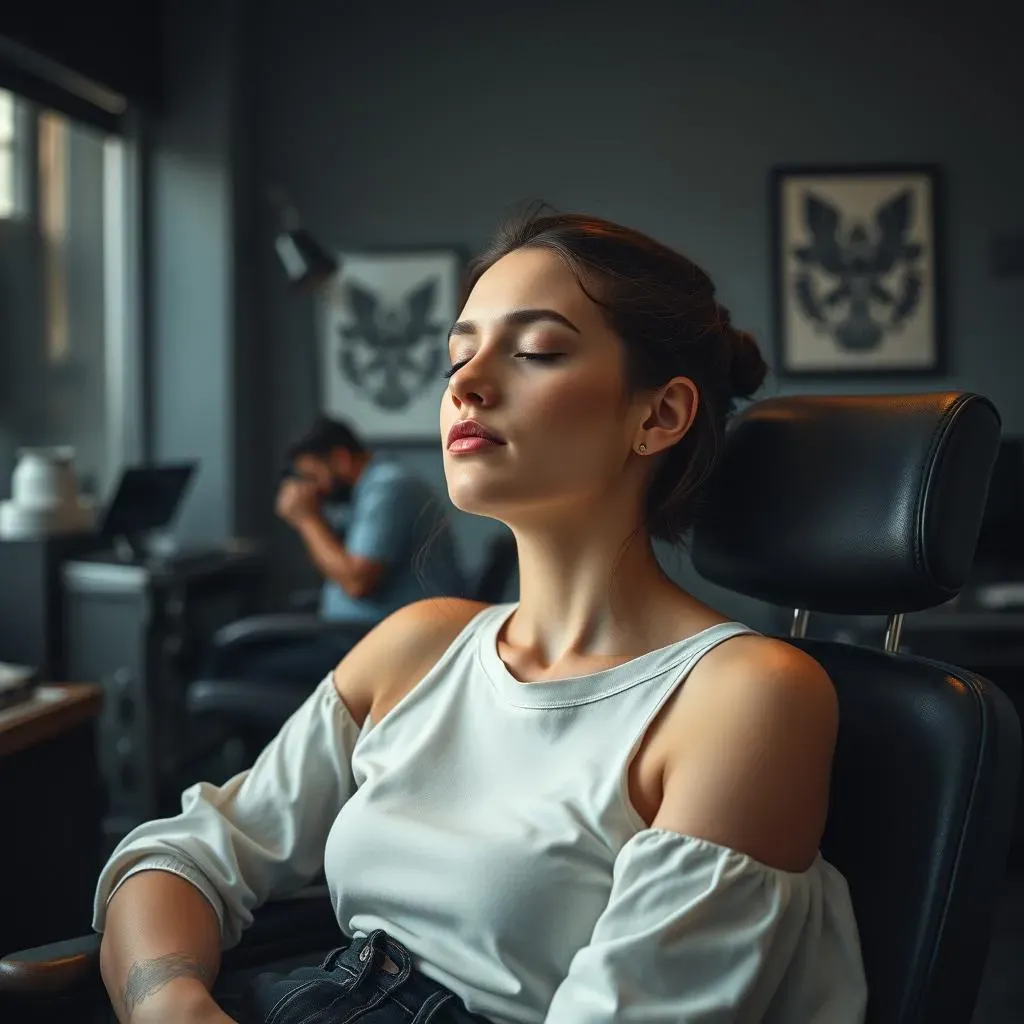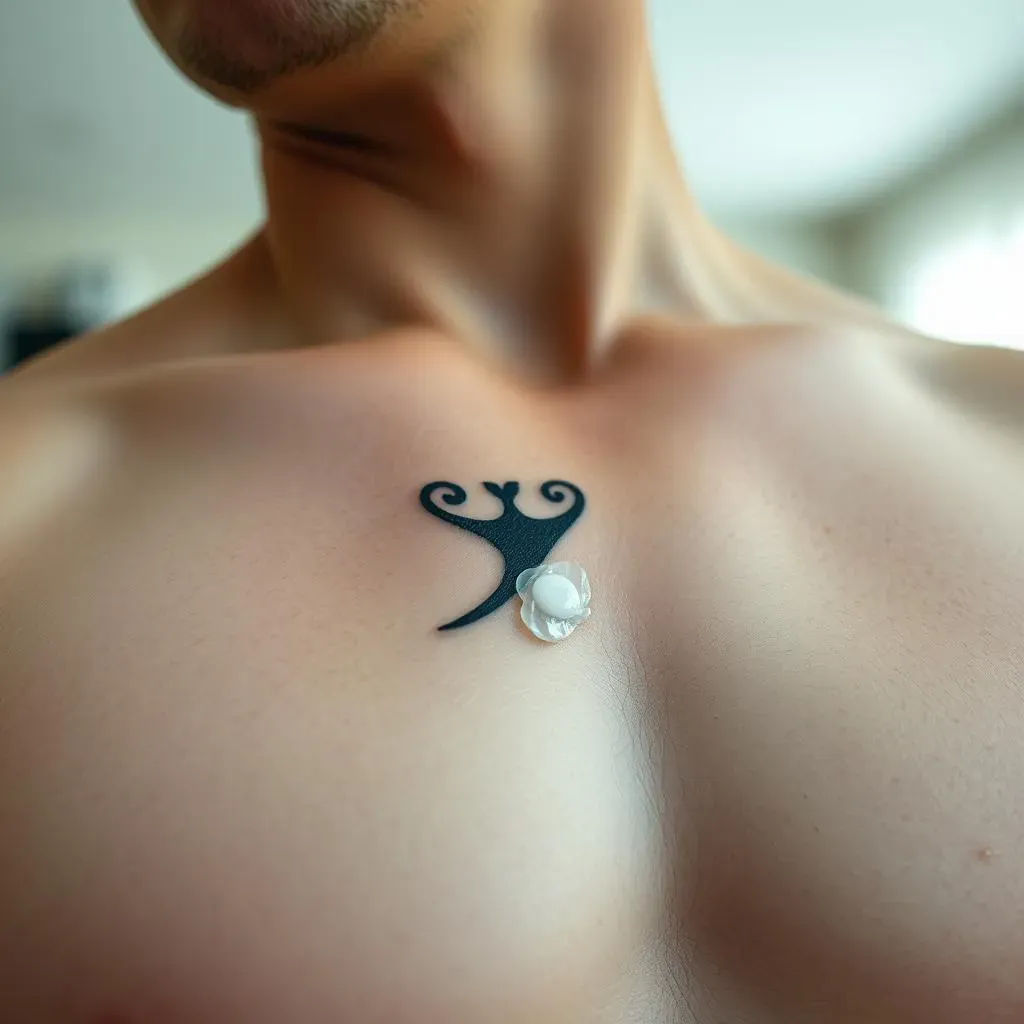Table of Contents
Thinking about getting a chest tattoo? It's a bold choice, a statement piece, but let's be real: chest tattoo pain is a significant consideration. This isn't just about a pretty picture; it's about understanding what you're getting into. This article is your roadmap to navigating the world of chest tattoo pain. We'll break down the pain levels you can expect in different areas of your chest, exploring why some spots hurt more than others. Discover the surprising factors that influence your experience, from your body type to your tattoo artist's skill. We'll also arm you with practical tips and techniques to minimize discomfort during your session and speed up your healing process. From pre-tattoo prep to post-tattoo aftercare, we'll cover it all. This isn't about avoiding pain entirely—that's unrealistic—but about making informed choices and managing your expectations. Get ready to demystify chest tattoo pain and confidently make the decision that's right for you. Let's dive in!
Understanding Chest Tattoo Pain Levels
Understanding Chest Tattoo Pain Levels
The Sternum: A Bone to Contend With
Let's talk about the sternum, that bony plate in the middle of your chest. It's like a shield protecting your vital organs, but for tattooing, it's a major pain point. The skin over the sternum is thin, with very little fat or muscle to cushion the needle's work. This means the needle is closer to the bone and nerve endings, resulting in a more intense, sharper sensation. Think of it like tapping a drum directly on the skin versus tapping it through a thick blanket. The drum (your bone) is much more directly affected without the padding.
Many people describe the pain as a deep, throbbing ache, almost like a constant pressure. The closer the tattoo gets to the edges of the sternum, where it meets the ribs, the more intense the pain tends to become. So, if you're planning a large chest piece that covers the sternum, be prepared for a more intense experience. For smaller tattoos, you might consider placement away from the sternum. Check out some small chest tattoo ideas for inspiration.
Area | Pain Level (1-10) | Description |
|---|---|---|
Sternum | 8-10 | Sharp, throbbing, intense |
Pectoral Muscles | 5-7 | Moderate, manageable |
Rib Cage | 7-9 | Sharp, stinging |
Pectorals: A Relatively Pain-Tolerant Zone
Now, let's shift our focus to the pectoral muscles, those lovely chest muscles that give your torso its shape. These areas are generally more forgiving when it comes to tattooing. The pectoral muscles have a good layer of muscle and fat, providing a buffer between the needle and the bone. This means the pain is usually less intense and more manageable than in areas like the sternum or ribs. Many people describe the feeling as a dull ache or a mild stinging sensation.
While not completely painless, the pectorals offer a more comfortable tattooing experience compared to other parts of the chest. This makes them a popular spot for larger tattoos, since the pain is less likely to become unbearable during long sessions. If you're looking for a less painful option, focusing your design on the pectoral muscles is a smart move. Consider incorporating these muscles into a larger piece that extends to the shoulders. For more ideas, browse some chest and shoulder tattoo designs.
- More muscle and fat = less pain.
- Pain is often described as a dull ache.
- Good choice for larger tattoos.
Rib Cage: Where Things Get a Bit More Intense
Finally, let's discuss the rib cage, which is often considered one of the most painful areas to get tattooed anywhere on the body. The skin here is thin, stretched tightly over bone, and packed with nerve endings. This combination makes for a very sensitive area, and the pain is often described as sharp, intense, and even burning. The ribs themselves are very close to the surface, leading to a particularly uncomfortable experience.
Many people find that the pain intensifies when the tattoo artist works over the bony parts of the ribs. The feeling is often described as sharp, stinging sensations, sometimes accompanied by a dull ache. If you're planning a tattoo that includes the rib cage, be prepared for a higher pain level. Consider breaking the session into multiple appointments to minimize the overall discomfort. For inspiration on chest pieces that incorporate the ribs, check out chest piece tattoo ideas.
Factors Influencing Pain During Chest Tattooing
Factors Influencing Pain During Chest Tattooing
Your Pain Tolerance: A Personal Equation
Let's face it: pain is subjective. What one person finds excruciating, another might consider a mild inconvenience. Your individual pain tolerance plays a massive role in your chest tattoo experience. Some people are naturally more sensitive to pain than others, and there's not much you can do to change that inherent sensitivity. Think of it like spice tolerance – some people love the burn, others prefer mild flavors. It's all about your personal threshold.
Factors like stress levels, sleep, and even your menstrual cycle (for women) can also impact your pain perception. A well-rested, relaxed individual might experience less pain than someone who's stressed and sleep-deprived. It's worth noting that even experienced tattoo enthusiasts can have different pain experiences depending on the day and their overall well-being. While you can't control your inherent pain tolerance, you can optimize your physical and mental state before your appointment. To get some inspiration for your chest tattoo, check out these chest tattoo ideas with meaning.
- Pain tolerance varies greatly between individuals.
- Stress, sleep, and overall well-being influence pain perception.
- Even experienced tattoo-goers can experience varying pain levels.
The Tattoo Itself: Size, Style, and Technique
The tattoo itself is another major player in the pain game. Larger tattoos naturally take longer, leading to increased overall discomfort. Think of it like running a marathon versus a sprint – the longer the session, the more your body tires, and the more sensitive you become to pain. The style of your tattoo also matters. Intricate designs with fine lines and shading often require more passes with the needle, potentially increasing the pain. A solid, bold design will generally be less painful than a complex, detailed piece.
Your artist's technique also makes a difference. A skilled artist who uses a light touch and knows how to work with the skin's contours will minimize discomfort. An experienced artist will also understand how to manage pain and will be able to work with you to ensure a comfortable experience. Conversely, a less skilled artist might cause more pain due to their technique. Therefore, choosing a reputable and experienced artist is crucial for a less painful tattoo experience. If you're looking for a specific style, you might want to explore these traditional chest tattoos.
Factor | Impact on Pain |
|---|---|
Tattoo Size | Larger tattoos generally cause more pain due to longer sessions. |
Tattoo Style | Intricate designs often lead to more pain. |
Artist's Technique | A skilled artist can minimize discomfort. |
Minimizing Discomfort: Tips and Techniques
Minimizing Discomfort: Tips and Techniques
Preparation is Key: Pre-Tattoo Strategies
Let's talk about prepping for your tattoo. Think of it like training for a marathon – you wouldn't just show up without any preparation, right? Similarly, taking steps before your appointment can significantly impact your comfort level. First, get a good night's sleep. Being well-rested reduces your overall sensitivity to pain. Eat a nutritious meal beforehand; low blood sugar can increase your pain perception. Avoid alcohol and caffeine, as they can thin your blood and make you more sensitive.
Consider over-the-counter pain relievers like ibuprofen, but always check with your artist first. They can advise you on what's safe and won't interfere with the tattoo process. Finally, communicate with your artist! Let them know if you're nervous or have any concerns about pain. A good artist will work with you to make the experience as comfortable as possible. They might suggest techniques or breaks to help you manage the discomfort. For some cool designs, check out these cool chest tattoos.
- Get a good night's sleep.
- Eat a nutritious meal.
- Avoid alcohol and caffeine.
- Communicate with your artist.
During the Tattoo: Managing the Moment
Once you're in the artist's chair, there are still things you can do to manage the pain. Deep, controlled breathing can help calm your nerves and reduce discomfort. Focus on your breathing; it's a simple yet powerful technique to distract yourself from the sensation of the needle. Listen to music or a podcast; distraction is your friend. Don't hesitate to take breaks if you need them. Your artist will understand; a short break will help you refocus and reduce the intensity of the pain.
Stay hydrated throughout the session. Dehydration can increase sensitivity and fatigue, making you more susceptible to pain. If you feel any discomfort, let your artist know immediately. They might adjust their technique or offer a break. Remember, communication is key to a comfortable experience. They're professionals, and they're there to help you feel as comfortable as possible. For some unique ideas, consider these unique chest tattoos.
Technique | Benefit |
|---|---|
Deep breathing | Calms nerves, reduces pain perception. |
Distraction (music, podcasts) | Diverts attention from the needle. |
Hydration | Reduces sensitivity and fatigue. |
Chest Tattoo Aftercare: Healing and Pain Management
Chest Tattoo Aftercare: Healing and Pain Management
Immediate Post-Tattoo Care
The first few days are crucial. Your artist will likely apply a bandage; leave it on for the recommended time. Once removed, gently wash the area with a mild, fragrance-free soap and lukewarm water. Pat it dry—don't rub! Apply a thin layer of the aftercare product your artist recommended. This usually involves a fragrance-free lotion or ointment to keep the area moisturized and prevent scabbing. Avoid touching the tattoo unnecessarily, and definitely keep your grubby mitts off it. This helps prevent infection and promotes faster healing. Remember, your chest is a pretty prominent area, so keeping it clean is especially important.
During this initial healing phase, you might experience some soreness, swelling, and even mild itching. This is normal. Avoid picking at any scabs that may form; let them fall off naturally. Picking can lead to scarring or infection. Keep the area clean and moisturized, and avoid tight clothing that might rub against the tattoo. Resist the urge to pick! It might seem tempting, but trust me, you'll thank yourself later. If you're looking for inspiration for your next tattoo, check out our selection of color chest tattoos.
- Leave the bandage on as directed.
- Wash gently with mild soap and water.
- Apply aftercare product as instructed.
- Avoid touching or picking at the tattoo.
Long-Term Healing and Pain Management
As the weeks progress, the healing process continues. The initial soreness and swelling will subside, but the area might remain slightly sensitive for several weeks. Keep moisturizing the tattoo regularly, especially during the first month. This prevents dryness and helps maintain the vibrancy of the ink. Avoid sun exposure as much as possible, as UV rays can fade the ink and irritate the skin. Use a high SPF sunscreen whenever you're going to be out in the sun.
If you experience excessive pain, swelling, redness, or any signs of infection (pus, fever, etc.), contact your doctor or tattoo artist immediately. These could indicate a problem that needs professional attention. And remember, your body is unique; the healing process might take longer or be more intense than others. Be patient, follow your artist's advice, and take care of your new ink. If you're looking for a larger design, take a look at our large chest tattoo ideas for inspiration.
Week | Expected Healing Stage | Care Tips |
|---|---|---|
1-2 | Soreness, swelling, some scabbing | Keep clean, moisturize, avoid sun |
3-4 | Scabs falling off, reduced soreness | Continue moisturizing, avoid sun |
4+ | Fully healed, minimal sensitivity | Maintain moisturizing, use sunscreen |